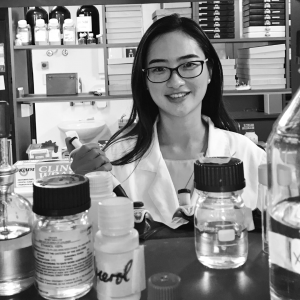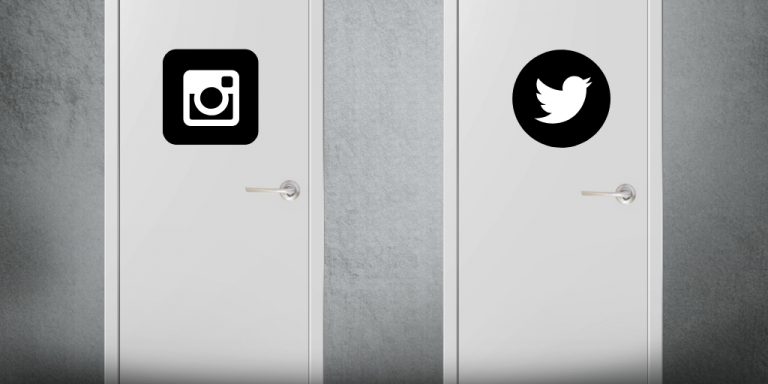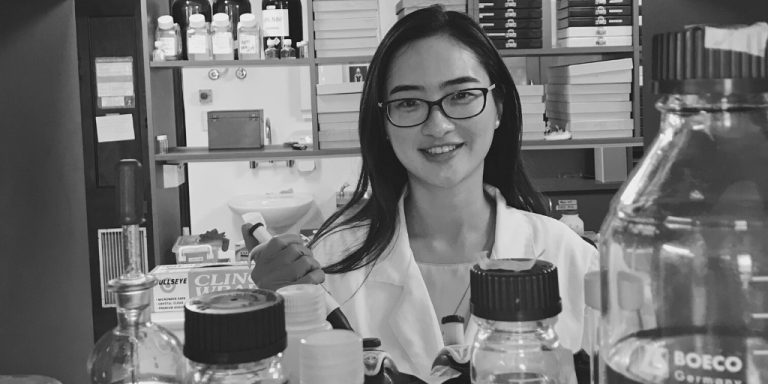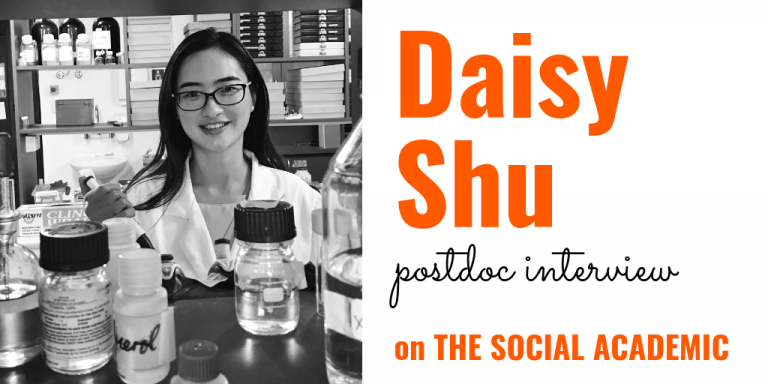Postdoc Daisy Shu Talks Science Communication on Instagram
Daisy Shu is all about eyes
Daisy Shu, a postdoc at Harvard’s Schepens Eye Research Institute, uses social media to share her research life.

Daisy’s PhD thesis explores how cataracts are formed, and “how we can prevent it from forming from a molecular biology perspective.” Now she’s made the journey from Sydney, Australia to Boston to research diseases of the retina.
In our interview, she discusses her social media journey. From first hearing Hugh Kearns speak, to starting her popular Instagram channel in October.
I love featuring academics like Daisy. She’s awesome at sharing what she does with her social media audiences. And, she has some great advice for you.
Meet Daisy
Subscribe to the podcast on Spotify | YouTube | TuneIn | ListenNotes | Blubrry
Jennifer: Hi, Daisy. Welcome to The Social Academic.
Tell me a bit about you.
Daisy: Hi, Jen.
I am a PhD student that just submitted my thesis.
And I did that in cataract research. So I am particularly interested in how eye diseases develop. And how we can find novel means of preventing them from forming.
Just as I submitted, I’ve made my way over to Boston from Sydney.
I’m starting my postdoc now at Harvard at an institute called Schepens Eye Institute. Now I’m looking at diseases of the retina.
Jennifer: OK, so a little bit of a transition into a new role, a new area, and also new research.
Daisy: Yeah, yeah! It’s been pretty difficult adjusting to the climate over here in Boston.
But aside from that, everyone in the lab has been really welcoming. So it’s been really easy to transition into this new role.
Jennifer: Oh, that’s wonderful.
Daisy: Yeah, it’s really great.
Jennifer: And do you like the area? I bet it was a big move from Sydney.
Daisy: Yeah, definitely.
Boston is actually a really nice city. It’s quite a small city, so it’s easy to make your way around places.
Jennifer: Absolutely.
Daisy: Yeah, yeah. It’s actually surprisingly small. So you don’t need a car to get around.
And everyone is really nice here.
I really like all the history about this place. It’s actually one of the oldest cities in America, which is pretty cool.
Jennifer: Yeah, I grew up right outside of Boston. So I was excited when I saw that you were headed there.
So I’d love to hear about how you started using social media to talk about your work and your research.
Subscribe to The Social Academic blog.
The form above subscribes you to new posts published on The Social Academic blog.
Want emails from Jennifer about building your online presence? Subscribe to her email list.
Looking for the podcast? Subscribe on Spotify.
Prefer to watch videos? Subscribe on YouTube.
Inspired to join social media

He’s an Australian researcher who really likes to promote science communication via social media.
Jennifer: Yeah!
Daisy: Yeah!
So he actually really inspired it.
So after that talk I signed up for Twitter. And I created the @EyeDaisyShu account.
But I actually never really used it because I didn’t really…I was too distracted by my research, my experiments.
I didn’t really engage via Twitter.
Jennifer: Right.
Daisy: Yeah, it was surprising.
It wasn’t until the beginning of last year when I started talking to a lot of people…some of the early career researchers who were already postdocs…
I attended an event. I think it was something to do with social media. And it was run by Franklin Women, a group in Sydney that promotes women in science.
Jennifer: Oh, wonderful.
Daisy: Yeah, that was something, one of my first posts, about attending that event.
And then from there, I found a lot of friends who are very active on Twitter.
And from there, I became someone who posted quite frequently…
“I previously just had a personal Instagram”

…But for Instagram, it wasn’t until last year in October.
Having been inspired by some of my lab mates, that I started my own Instagram account.
I previously just had a personal Instagram.
Jennifer: Right, of course.
Daisy: I saw the benefit in that.
It was also inspired by the ARVO webinar that you were a part of.
Jennifer: Oh, I love that.
Daisy: Yeah, on social media.
Yeah, I was like, “Oh, I need to get on this.”
After the @ARVOinfo webinar for the #SciComm Fellowship with @profswatson @HigherEdPR on how to use Twitter and Instagram to communicate our research, I have now started my own #Instagram! #followme https://t.co/k8I0t9O07R Thanks @MWindsorPhD for organising this #phdchat #scicomm pic.twitter.com/RLWfzRA3GU
— Daisy Shu (@EyeDaisyShu) October 11, 2018
Jennifer: Now, the social media account that your labmates run, was that a kind of group effort, or was that 1 or 2 people that were working on that?
Daisy: We had a lab specific one. Everyone had the password for that.
But my friend had a spinoff one. She’s Taylor Wishart who’s @MyLifeInTheLab
Jennifer: Oh, OK! Yeah, absolutely.
Daisy: She had her own personal one where she shared her research journey.
I thought that was an excellent idea, to have my own spinoff one.
So in addition to my lab one, which was shared, I thought it was nice to have that personal touch.
Jennifer: Yeah, absolutely.
I think that people really connect with people who are trying to share science stories and talk about what life is actually like in a lab.
Daisy: Yeah, yeah. Exactly.
Subscribe to The Social Academic blog.
The form above subscribes you to new posts published on The Social Academic blog.
Want emails from Jennifer about building your online presence? Subscribe to her email list.
Looking for the podcast? Subscribe on Spotify.
Prefer to watch videos? Subscribe on YouTube.
Daisy likes Instagram and Twitter for different reasons

Jennifer: So what’s your favorite social media platform?
It sounds like you started on Twitter and then joined Instagram to talk about your research. Which is your favorite?
Daisy: I would have to say that I really appreciate those platforms in different ways.
So with Twitter, it’s all about sharing links and retweeting. It’s made really simple on Twitter, and it’s not as easy to do that on Instagram.
You can repost, but it’s not…it’s almost nicer to have your own images on Instagram.
And when I do share, or repost, it’s typically an Insta story that I would do that in.
Jennifer: Something that’s temporary, and that people will actually click on. Something that people may actually go look at the thing you’re talking about.
Daisy: Yeah, exactly.
So I use them for different purposes.
With Instagram, I find it’s definitely more visually fun and engaging, with videos and photos.
So that is something I feel like a lot of people would gravitate towards easily.
Twitter on the other hand, I feel like is something a lot of the older academics use more.
So I find I engage with more postdocs and professors via Twitter.
And I engage more with PhD students or early sort of postdocs via Instagram.
Jennifer: Oh, that’s really interesting.
There is a bit of an age divide.
I wonder if it is about the visual aspect of Instagram.
I’ve heard people saying they’re nervous about taking their own photos, or that they don’t think they’re a photographer.
Daisy: Yeah.
Jennifer: One of the things that I like about Instagram is that there are all sorts of new things now.
Like polls, and things to engage in stories like music, that aren’t just visual.
Daisy: Yeah, that’s really exciting. I haven’t actually tried the music option. But that is really nice to add to Instagram.
Jennifer: Yeah, it’s brand new. I think people are still testing it out and seeing how it works.
But it’s a cool new feature, definitely.
So what types of ways do you usually engage with your followers?
You said you share links on Twitter and share more visual stuff on Instagram…
But how do you engage with the people who follow you – your audience?
Asking questions on social media starts conversations

Daisy: On Instagram, when I want to get more engagement, I typically try to ask questions in my posts.
In hoping people will reply…
On Twitter it’s more like…more posts that someone will end up retweeting, replying, or commenting.
I haven’t really used questions much on Twitter.
It seems to create more hype when you do have a post that is interesting.
Jennifer: Something that sparks conversation.
Daisy: Yeah, exactly.
So not so much direct questions. But really just rather sharing a link that’s really interesting, or a quote. And that will spark engagement itself.
Whereas on Instagram, people sometimes comment. But usually it’s more engaging to specifically ask a question.
Jennifer: Yeah, absolutely.
So, what advice would you give to a new researcher or academic who is thinking about joining social media?
“Create an account now,” social media advice

Daisy: I would have to say that create an account now. Like as soon as possible.
Then you can get the name you really want.
It’s all about not delaying it.
Sometimes I feel like it’s really easy to just sit on it and think I’m going to plan it out thoughtfully, and carefully, and create the personal Instagram feed that encapsulates myself.
But the more you sit on it…and I felt like I did that with my Twitter when I actually started it.
I didn’t really engage and post things until 2017.
So I felt like the thing is just to start.
And through starting you’ll develop your own sort of feed organically.
And you’ll meet other people and they’ll inspire different sorts of posts.
And it’s only through actually doing it that you can learn exactly what social media is all about.
Jennifer: I love that.
Just doing it is really great advice.
I know for myself, I was private on social media for a very long time.
One day I just decided, OK well I’m going to try not doing that…and took all my accounts public.
And I really enjoyed it! It was surprising.
Daisy: Yeah.
It’s really great to hear from people you don’t know who are interested in your work.
Jennifer: Yeah! Sometimes it can start fun conversations, and even collaborations.
I love that social media can really connect people.
Daisy: Yeah, yeah. It really can.
Daisy’s PhD thesis explores how cataracts are formed & “how we can prevent it from forming from a molecular biology perspective.”
— The Academic Designer (@HigherEdPR) April 20, 2019
Now she’s made the journey from Sydney, Australia to Boston to research diseases of the retina @eyedaisyshu #scicomm #postdoc https://t.co/wm2KqERdlt pic.twitter.com/QMSyMAddOY
Crowdfunding your research

Jennifer: The last thing I wanted to ask you about is your experience crowdfunding your research.
I noticed that you had raised some money to help support your lab research in the past and I was wondering if you could tell us a bit about that.
Daisy: Yeah, so I crowdfunded my PhD project which was really exciting.
It was actually part of the [Association for Research in Vision and Ophthalmology] ARVO science communication training program, where we had to do our own outreach assignment.
And there were a lot of different ideas.
People in my cohort did different things like hosting a lab day where patients who had the disease they were studying would come over and they’d show them the sort of experimental side of what was happening in terms of their research. And that was a really cool idea.
But I decided to do mine completely online through crowdfunding. And that actually was a very interesting experience.
Me creating a video that encapsulated exactly what my research was, but directed towards a very general audience.
Jennifer: Right.
Daisy: Yeah. That was quite a challenge in itself. I had really only written more scientific things about my research.
That was a good learning experience for me.
Jennifer: Yeah, great outreach and practice talking to a really public audience.
And explaining…justifying to them why money is important to help this particular project. Absolutely.
Daisy: Yeah. Exactly.
We were very specific as to where the money would be going, what re-agents we would be purchasing.
And it was amazing to find that some people who were suffering from cataracts were very keen on donating to me. And they were actually strangers.
Jennifer: How did you share that once you had written up the call for funds?
Did you share that on social media?
Daisy: Yeah. That was an interesting one where I found that the most effective form to engage with people was via Facebook, which was my personal Facebook account.
But I found that was actually a bit more engaging. And Facebook is something that I haven’t really utilized as much.
And that’s something I’ll be looking into for the future.
I found Facebook was actually more effective for my crowdfunding and creating more engagement.
But I did share it on Instagram and Twitter. And I made sure to post at least once a week, just so I could catch everybody and not miss any potential donators.
Yeah, so that was a good experience.
And I also tried via email. That was another form of connecting with others, telling people about it.
Jennifer: So it sounds like sharing widely, and sharing multiple times so that your audience can definitely hear it.
Some people aren’t on social media or checking their email everyday. So having it across platforms really helps get your message out there.
Daisy: Yeah, exactly.
Subscribe to The Social Academic blog.
The form above subscribes you to new posts published on The Social Academic blog.
Want emails from Jennifer about building your online presence? Subscribe to her email list.
Looking for the podcast? Subscribe on Spotify.
Prefer to watch videos? Subscribe on YouTube.
Find Daisy on Twitter and Instagram

Jennifer: Well I love that. Thank you so much for coming to talk with me today about social media and your practices.
Is there anything else that you would like to add or plug?
Daisy: I guess I’ll plug my Instagram.
Jennifer: Oh yeah, definitely. Everyone should check out your Instagram, it’s so fun.
Daisy: Yeah. And I’m always up for sort of conversations, comments. I really like it when people engage with me.
Definitely look out for my Instagram and Twitter at @EyeDaisyShu.
Jennifer: Wonderful. Thank you so much. And we look forward to seeing more from you in Boston.
Daisy: Yay! I’m excited to share more things.
Subscribe to The Social Academic blog.
The form above subscribes you to new posts published on The Social Academic blog.
Want emails from Jennifer about building your online presence? Subscribe to her email list.
Looking for the podcast? Subscribe on Spotify.
Prefer to watch videos? Subscribe on YouTube.
Bio for Schepen’s Eye Institute Postdoc researcher, Daisy Shu

Daisy Shu is a PhD student at the University of Sydney. She studies how cataract forms and how it can be treated from a molecular biology perspective.
She is passionate about science communication and enjoys sharing her research journey via social media @EyeDaisyShu
You can find Daisy on Twitter, Instagram, and LinkedIn.
Jennifer van Alstyne View All →
Jennifer van Alstyne is a Peruvian-American poet and communications consultant. She founded The Academic Designer LLC to help professors build a strong online presence for their research, teaching, and leadership. Jennifer’s goal is to help people feel confident sharing their work with the world.
Jennifer’s personal website
https://jennifervanalstyne
The Academic Designer LLC
https://theacademicdesigner.com
